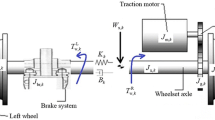Abstract
Monitoring the wheel-rail adhesion state and maintaining the stability are the key issues to ensure the safety of locomotives with increasing running speed nowadays. In this paper, a novel methodology is proposed to determine the wheel-rail adhesion stability. It is proved that when the adhesion state is in the unstable region, the transmitting factor which is defined as the ratio of the adhesion force in the wheel drive force is negative. Based on this principle, we propose a novel adhesion stability detector via measuring the wheel drive torque and the wheel rotational speed. It is free from measuring or determining the chassis speed, creep ratio, and optimal creep ratio, which are usually difficult to obtain in practical applications. In addition, the proposed methodology can evaluate the adhesion state dynamically regardless of the specific wheel-rail conditions. Numerical simulations are carried out to validate its effectiveness.
Similar content being viewed by others
References
Kawamura, A., Furuya, T., Takeuchi, K., Takaoka, Y., Yoshimoto, K., and Cao, M., “Maximum Adhesion Control for Shinkansen using the Tractive Force Tester,” Proc. of IEEE 28th Annual Conference of the Industrial Electronics Society, Vol. 1, pp. 567–572, 2002.
Park, S. H., Kim, J. S., Choi, J. J., and Yamazaki, H. O., “Modeling and Control of Adhesion Force in Railway Rolling Stocks,” IEEE Control Systems, Vol. 28, No. 5, pp. 44–58, 2008.
Cheok, A. D. and Shiomi, S., “Combined Heuristic Knowledge and Limited Measurement based Fuzzy Logic Antiskid Control for Railway Applications,” IEEE Transactions on Systems, Man, and Cybernetics, Part C: Applications and Reviews, Vol. 30, No. 4, pp. 557–568, 2000.
Bouscayrol, A., Pietrzak-David, M., Delarue, P., Pena-Eguiluz, R., Vidal, P.-E., and Kestelyn, X., “Weighted Control of Traction Drives with Parallel-Connected AC Machines,” IEEE Transactions on Industrial Electronics, Vol. 53, No. 6, pp. 1799–1806, 2006.
Zuo, J. Y. and Chen, Z. K., “Antiskid Control of Railway Train Braking based on Adhesion Creep Behavior,” Chinese Journal of Mechanical Engineering, Vol. 25, No. 3, pp. 543–549, 2012.
Ohishi, K., Hata, T., Sano, T., and Yasukawa, S., “Realization of Anti-Slip/Skid Re-Adhesion Control for Electric Commuter Train based on Disturbance Observer,” IEEJ Transactions on Electrical and Electronic Engineering, Vol. 4, No. 2, pp. 199–209, 2009.
Shimizu, Y., Kadowaki, S., Ohishi, K., Hata, T., Sano, T., and Yasukawa, S., “Evaluation and Discussion of Disturbance Observerbased Anti-Slip/Skip Readhesion Control for Electric Train,” Electrical Engineering in Japan, Vol. 169, No. 4, pp. 55–64, 2009.
Shirai, S., “Adhesion Phenomena at High-Speed Range and Performance of an Improved Slip-Dectector,” Quarterly Reports, Railway Technical Research Institute, Vol. 18, No. 4, pp. 189–190, 1977.
Hubbard, P. D., Ward, C., Dixon, R., and Goodall, R., “Models for Estimation of Creep Forces in the Wheel/Rail Contact under Varying Adhesion Levels,” Vehicle System Dynamics, Vol. 52, No. Suppl. 1, pp. 370–386, 2014.
Baek, K. S., Kyogoku, K., and Nakahara, T., “Influence of Parameters on the Transient Traction of Wheel/Rail Contact under Low-Speed and Wet Conditions,” Journal of Japanese Society of Tribologists, Vol. 52, No. 5, pp. 359–366, 2007.
Zhu, Y. and Olofsson, U., “An Adhesion Model for Wheel–Rail Contact at the Micro Level using Measured 3D Surfaces,” Wear, Vol. 314, No. 1, pp. 162–170, 2014.
Ryoo, H. J., Kim, S. J., Rim, G. H., Kim, Y. J., and Kim, M. S., “Novel Anti-Slip/Slide Control Algorithm for Korean High-Speed Train,” Proc. of the 29th Annual Conference on Industrial Electronics Society, Vol. 3, pp. 2570–2574, 2003.
Park, D. Y., Kim, M. S., Hwang, D. H., Lee, J. H., and Kim, Y. J., “Hybrid Re-Adhesion Control Method for Traction System of High-Speed Railway,” Proc. of the Fifth International Conference on Electrical Machines and Systems, Vol. 2, pp. 739–742, 2001.
Takaoka, Y. and Kawamura, A., “Disturbance Observer based Adhesion Control for Shinkansen,” Proc. of 6th International Workshop on Advanced Motion Control, pp. 169–174, 2000.
Kawamura, A., Takeuchi, K., Furuya, T., Takaoka, Y., Yoshimoto, K., and Cao, M., “Measurement of the Tractive Force and the New Adhesion Control by the Newly Developed Tractive Force Measurement Equipment,” Proc. of the Power Conversion Conference, Vol. 2, pp. 879–884, 2002.
Park, S. H., Kim, J. S., and Choi, J. J., “Reference Slip Ratio Generation and Adaptive Sliding Mode Control for Railway Rolling Stocks,” Int. J. Precis. Eng. Manuf., Vol. 10, No. 2, pp. 39–44, 2009.
De Castro, R., Araujo, R. E., and Freitas, D., “Wheel Slip Control of EVs based on Sliding Mode Technique with Conditional Integrators,” IEEE Transactions on Industrial Electronics, Vol. 60, No. 8, pp. 3256–3271, 2013.
Yun, D. S., Kim, H. S., and Boo, K. S., “Brake Performance Evaluation of ABS with Sliding Mode Controller on a Split Road with Driver Model,” Int. J. Precis. Eng. Manuf., Vol. 12, No. 1, pp. 31–38, 2011.
Delli Colli, V., Tomassi, G., and Scarano, M., “Single Wheel Longitudinal Traction Control for Electric Vehicles,” IEEE Transactions on Power Electronics, Vol. 21, No. 3, pp. 799–808, 2006.
Ć irović, V., Aleksendrić, D., and Smiljanić, D., “Longitudinal Wheel Slip Control Using Dynamic Neural Networks,” Mechatronics, Vol. 23, No. 1, pp. 135–146, 2013.
Mason, S. J., “Feedback Theory — Some Properties of Signal Flow Graphs,” Proceedings of the Institute of Radio Engineers, Vol. 41, No. 9, pp. 1144–1156, 1953.
Ogata, K., “Modern Control Engineering,” Prentice Hall, 5th Ed., pp. 751–777, 2009.
Author information
Authors and Affiliations
Corresponding author
Rights and permissions
About this article
Cite this article
Xu, K., Xu, G. & Zheng, C. Novel determination of Wheel-Rail adhesion stability for electric locomotives. Int. J. Precis. Eng. Manuf. 16, 653–660 (2015). https://doi.org/10.1007/s12541-015-0087-0
Received:
Accepted:
Published:
Issue Date:
DOI: https://doi.org/10.1007/s12541-015-0087-0




